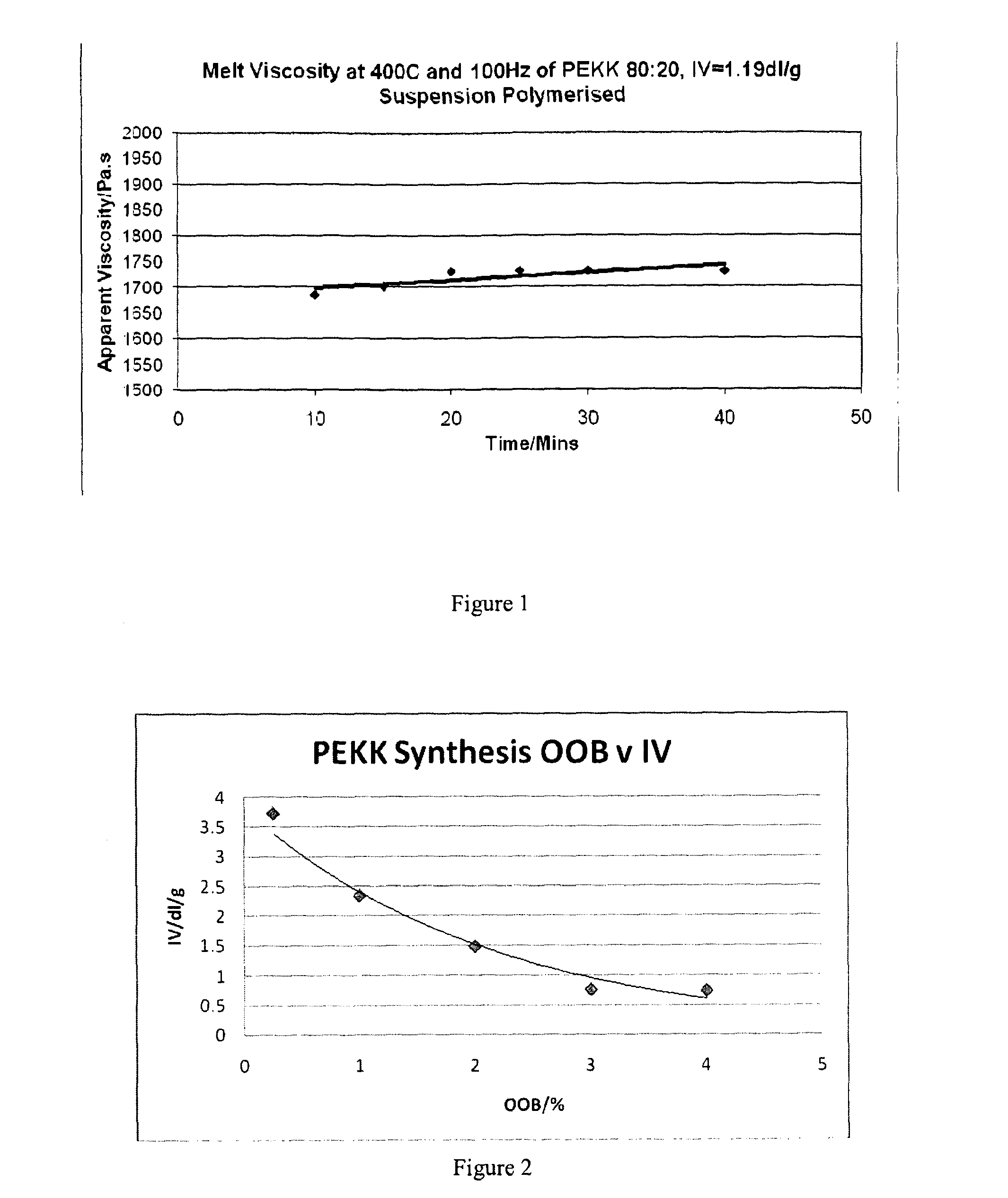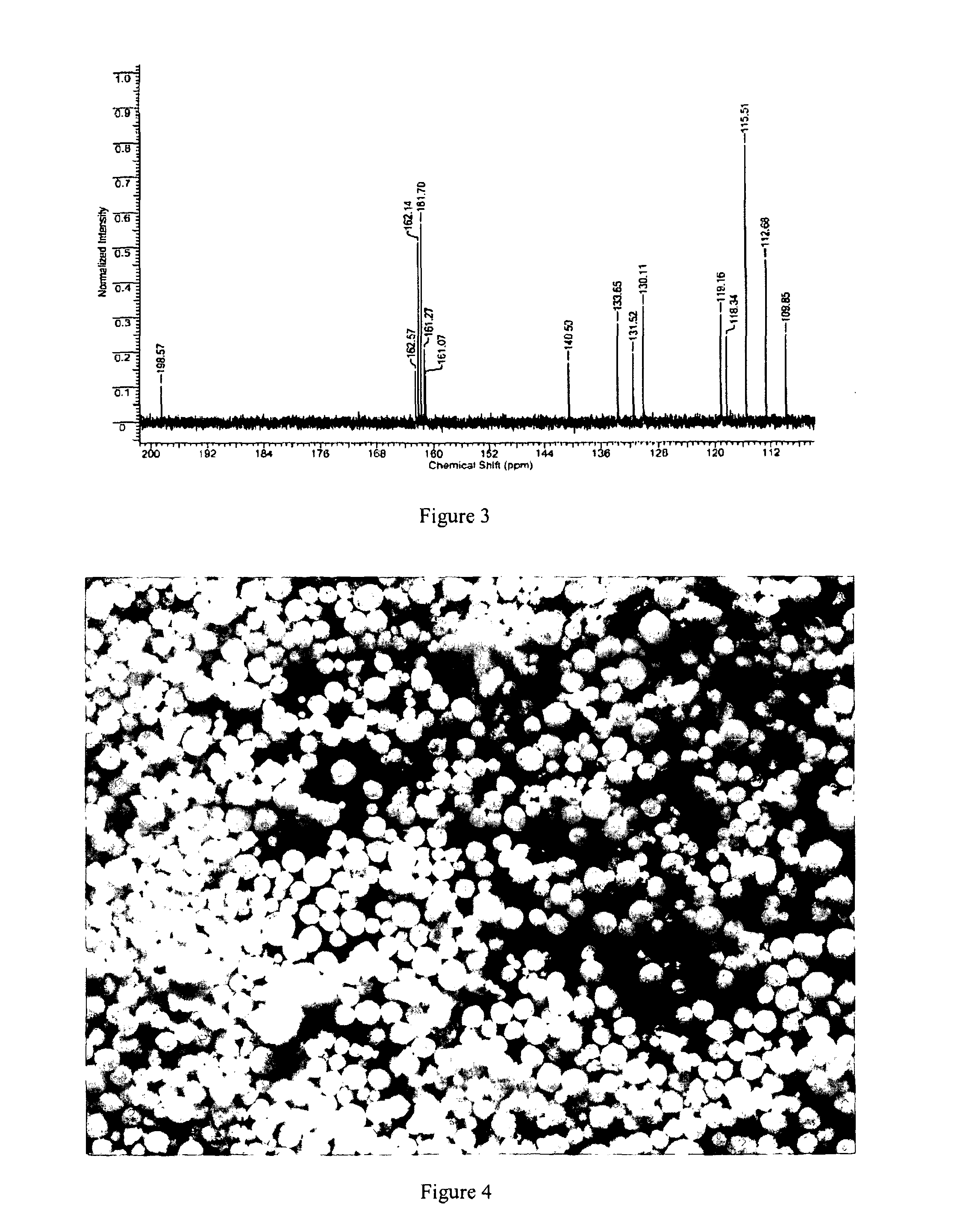Method for preparing poly (ether ketone ketones)
a technology of ether ketone and polyether, which is applied in the field of preparing polyether ketone, can solve the problems of affecting the performance in use, melting instability of polymers during processing, and high undesirable effects, and achieves the reduction of the effect of reducing the amount of water required, and reducing the volume of work-up vessels
- Summary
- Abstract
- Description
- Claims
- Application Information
AI Technical Summary
Benefits of technology
Problems solved by technology
Method used
Image
Examples
example 1
Synthesis of 80:20 PEKK in Balance
[0112]To a 700 ml reaction flask equipped with a mechanical stirrer, having been purged with dry nitrogen, was added 41.5608 g (0.08833 mol) of pure 1,4-bis(4-phenoxybenzoyl)benzene along with 300 ml of dichloromethane. Having cooled the slurry to −20° C., 100 g (0.75 mol) of anhydrous aluminium trichloride was slowly added so as not to raise the temperature of the slurry above −10° C. and to minimise any splashing up the walls of the reactor. After cooling back to −20° C., 17.9328 g (0.08833 mol) of a mixture of isophthaloyl chloride (7.1463 g) and terephthaloyl chloride (10.7865 g) was added to the slurry along with a further 100 ml of dichloromethane. Also at −20° C., 31.75 g (0.26 mol) of benzoic acid was added.
[0113]Whilst stirring at 100 rpm the reaction mass was allowed to warm towards room temperature without additional heating. During this period, the colour of the reaction mass changed from yellow to pale orange. As the mass showed signs o...
example 2
Synthesis of 80:20 PEKK 2.24% Out of Balance
[0118]The technique used was identical to that described in Example 1, but with the additional use of benzoyl chloride as a capping agent (which was added to the polymerisation mixture immediately after the benzoic acid). The reagents used were:[0119]1,4-bis(4-phenoxybenzoyl)benzene: 50.6331 g (0.1076 mol)[0120]Isophthaloyl and terephthaloyl chlorides: 21.3577 g (0.1052 mol)[0121]Isophthaloyl chloride: 8.7000 g[0122]Terephthaloyl chloride: 12.6577 g[0123]Benzoic acid: 39.42 g (0.3228 mol)[0124]Aluminium trichloride: 118.98 g (0.8923 mol)[0125]Benzoyl chloride: 0.6747 g (4.8×10−3 mol)[0126]Dichloromethane: 450 ml
[0127]The IV of the resultant polymer was 1.19 dL / g and the polymer had a viscosity of 1750 Pa·s at 400° C. and 100 Hz. The polymer was highly stable over 30 minutes at 400° C. The Tg was 165° C. and the Tm was 367° C. The yield of recovered dichloromethane and benzoic acid was similar to that in Example 1
example 3
Synthesis of 80:20 PEKK in Balance
[0128]The technique used was identical to that described in Example 1, except the benzoic acid controlling agent was replaced by benzene sulphonic acid. The reagents used were:[0129]1,4-bis(4-phenoxybenzoyl)benzene: 40.2923 g (0.08563 mol)[0130]Isophthaloyl and terephthaloyl chlorides: 17.3853 g (0.08563 mol)[0131]Isophthaloyl chloride: 7.3285 g[0132]Terephthaloyl chloride: 10.0568 g[0133]Benzene sulphonic acid: 41.08 g (0.26 mol)[0134]Aluminium trichloride: 83.8 g (0.63 mol)[0135]Dichloromethane: 400 ml
[0136]The IV of the resultant polymer was 2.40 dL / g. The yield of recovered dichloromethane was similar to that in Example 1.
PUM
| Property | Measurement | Unit |
|---|---|---|
| diameter | aaaaa | aaaaa |
| diameter | aaaaa | aaaaa |
| Tm | aaaaa | aaaaa |
Abstract
Description
Claims
Application Information
 Login to View More
Login to View More - R&D
- Intellectual Property
- Life Sciences
- Materials
- Tech Scout
- Unparalleled Data Quality
- Higher Quality Content
- 60% Fewer Hallucinations
Browse by: Latest US Patents, China's latest patents, Technical Efficacy Thesaurus, Application Domain, Technology Topic, Popular Technical Reports.
© 2025 PatSnap. All rights reserved.Legal|Privacy policy|Modern Slavery Act Transparency Statement|Sitemap|About US| Contact US: help@patsnap.com



